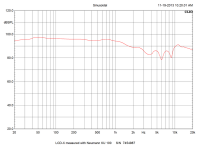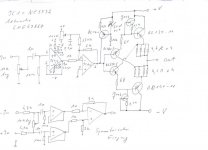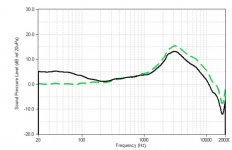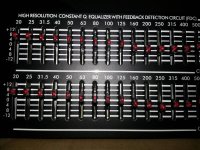Lately i worked quite a bit on EQ Headphones.
Even the best of them like the Audeze LCD-X have audible flaws.
Arnie Nudell identified some of them them in his review for Absolute Sound but my son an i found that this is only part of the truth.
Even the best of them like the Audeze LCD-X have audible flaws.
Arnie Nudell identified some of them them in his review for Absolute Sound but my son an i found that this is only part of the truth.
Measuring headphones with artificial heads is a difficult task. Guess the Neumann was equipped with ear impedance simulation.
Still working on your amp. 1 hour per week is not that productive ��
Still working on your amp. 1 hour per week is not that productive ��
a look at Tyll's measurement's reproducibility
Expert Tests InnerFidelity's Headphone Measurement Repeatability and Reproducibility | InnerFidelity
definite limits to headphone response "precision" - putting them on your head, if you have hair how the cups seal...
small position changes give big high frequency diff
Expert Tests InnerFidelity's Headphone Measurement Repeatability and Reproducibility | InnerFidelity
definite limits to headphone response "precision" - putting them on your head, if you have hair how the cups seal...
small position changes give big high frequency diff
I know that it is not easy to measure headphones and i hope i can expand a bit on the method i came up with.
First i just EQed the measured response.
I decided to work only on frequencies over 2kHz and doing a treble shelf so that high frequencies remain at ca. 90dB.
This are the settings :
2kHz +2dB
2.5kHz +2dB
3.135kHz +6dB
4kHz +7dB
6.3kHz +8dB
8kHz +6dB
First i just EQed the measured response.
I decided to work only on frequencies over 2kHz and doing a treble shelf so that high frequencies remain at ca. 90dB.
This are the settings :
2kHz +2dB
2.5kHz +2dB
3.135kHz +6dB
4kHz +7dB
6.3kHz +8dB
8kHz +6dB
That gave a clear improvement.
Besides the presence dip that Nudell mentioned this cans also mute the mid treble a bit.
On the other side the EQ was not fully satisfying.
Strings sounded a bit stingy and my son said that the perspective on the orchestra was a bit strange.
Some instruments that should be in the foreground sounded further away and vice versa.
Besides the presence dip that Nudell mentioned this cans also mute the mid treble a bit.
On the other side the EQ was not fully satisfying.
Strings sounded a bit stingy and my son said that the perspective on the orchestra was a bit strange.
Some instruments that should be in the foreground sounded further away and vice versa.
The next thing we did was using pink noise.
Pink noise is very good to hear frequencies that stand out from the rest.
We tried every 30 bands of the equalizer to hear what it does and after maybe half an hour we decided that it sounds very even, somehow like heavy rain i would say.
Switching back and forth it was clear that the un equalized response sounded a bit closed in and hooded.
Pink noise is very good to hear frequencies that stand out from the rest.
We tried every 30 bands of the equalizer to hear what it does and after maybe half an hour we decided that it sounds very even, somehow like heavy rain i would say.
Switching back and forth it was clear that the un equalized response sounded a bit closed in and hooded.
Then we used white noise. That brings out the treble quite a bit.
Again we did some fine tuning.
The next thing was brownian noise. That has an emphasis on the bass.
There still was some audible rumble there.
Again we did some fine tuning.
The next thing was brownian noise. That has an emphasis on the bass.
There still was some audible rumble there.
We then used a sine sweep at quite high volume.
Interesting enough we heard some resonances that sounded mechanical in the upper bass at ca. 160Hz and also at around 320Hz. That does not show in the artificial head measurement.
Interesting enough we heard some resonances that sounded mechanical in the upper bass at ca. 160Hz and also at around 320Hz. That does not show in the artificial head measurement.
We then used the sine sweep until no frequency stood out any more.
Of cause because of the Fletcher-Munson curve bass and treble does not sound as loud on a sweep then the presence range.
Of cause because of the Fletcher-Munson curve bass and treble does not sound as loud on a sweep then the presence range.
@Joachim, do your not believe in the target response curve research that Sean Olive and others have been doing? Headphone Target Response Curve Research Update | InnerFidelity. That seems to indicate that 3KHz should be around 8dB above the 1KHz level. Or does the neumann head take into account the ear canal and give you a deviation from target response?
I come to this point now.
For the first time we thought that our EQ sounded better then the untreated headphone.
Still there was a lack of substance.
I then looked up what are the recommended target responses.
The ones i found are the Olive one you mentioned and the other is from Golden Ears.
For the first time we thought that our EQ sounded better then the untreated headphone.
Still there was a lack of substance.
I then looked up what are the recommended target responses.
The ones i found are the Olive one you mentioned and the other is from Golden Ears.
Attachments
At this time we certainly did not want to mingle around with the presence range.
The Neumann head seems to have some compensation. Otherwise the Audeze would be really lacking bad in this range.
Where both target curves agree is a raise in response under 200Hz.
We implemented that and, voila ! A big improvement.
The Neumann head seems to have some compensation. Otherwise the Audeze would be really lacking bad in this range.
Where both target curves agree is a raise in response under 200Hz.
We implemented that and, voila ! A big improvement.
- Status
- Not open for further replies.
- Home
- Amplifiers
- Headphone Systems
- Precission EQ of Headphones







